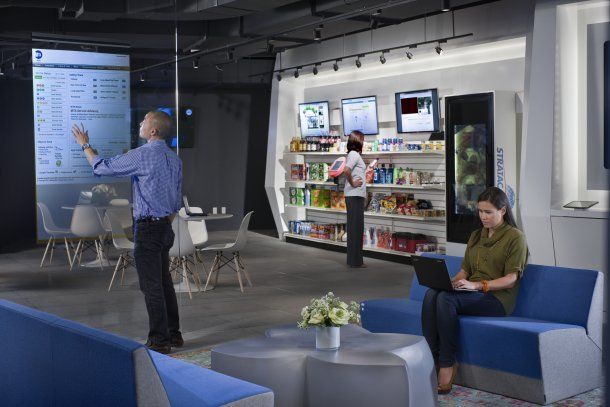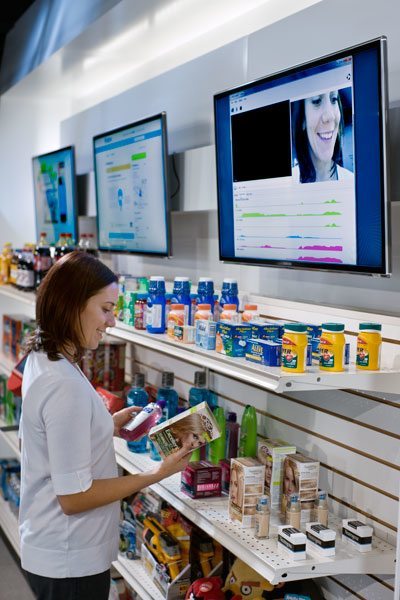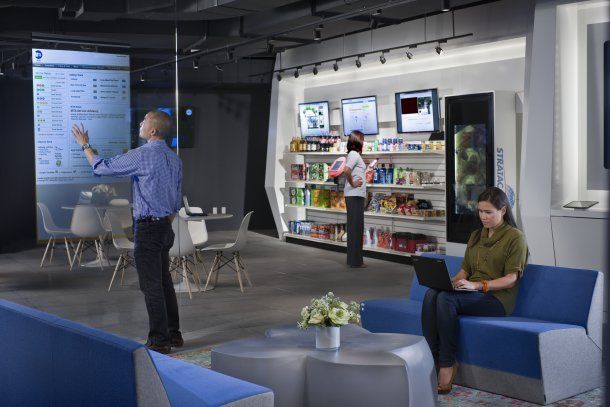
Lots of interactive signage goodies in IPG’s new(ish) media lab
November 10, 2011 by Dave Haynes
IPG Mediabrands, described as the “media innovation unit” of the $34-billion media holding company Interpublic Group, has launched a whiz-bang media lab in its New York offices.
The IPG Media Lab, says a release this morning, is the world’s first, and the industry’s most highly-invested immersion and exploration center dedicated to bringing the most promising technologies from Silicon Valley and the “Innovation Economy” together with leading global brands to create solutions for real-world marketing problems.
I am not quite sure how you launch something you already had, but I guess politicians re-announce projects and programs all the time and few people nit-pick. IPG has had an emerging media lab for at least a year and probably much, much longer.
Anyway, new or renovated, there’s lots of technology at play here to get brand people tingling and ensure IPG stays high on the Cool-O-Meter. Much of the featured products in the release are directly relevant to digital signage and digital out of home.
The 5,000-square-foot lab serves as Mediabrands’ digital inner sanctum and the physical location where clients and the IPG network will go to engage and develop technology-enabled marketing programs alongside proprietary data and analytics. The IPG Media Lab team has vetted and compiled a database of over 500 companies and continues to work with venture capital firms, small technology funds and thousands of emerging media companies around the world to review and assess new ways to connect consumers in the digital space. The companies chosen for inclusion in the IPG Media Lab compendium will be fed to all IPG Mediabrands employees.
At any given time, the Lab will feature 50 of these technologies, platforms and applications. These will be accessed within six permanent installations, or “Permatrends”: The Mobile World, Connected Entertainment & Experience, Retail Innovations, Social Media, Audience Measurement and Marketing Accountability. The Lab will continually improve and optimize the Lab experience through a proprietary feedback system, powered by Tagstand, which enables real-time monitoring of engagement throughout the space, leveraging NFC technology.
“Mediabrands is investing significantly in the future of brand communications,” said Matt Seiler, Global Chief Executive Officer, Mediabrands. “We, as partners to major international brands, have a duty to keep our clients and agency talent apprised of landscape changes and developing opportunities to engage a rapidly advancing global consumer.”
“This is the place where our clients can touch, interact and test the applications, platforms and technologies that will help grow their businesses while creating consumer utility that is value-driven,” said Quentin George, Chief Innovation Officer, Mediabrands. “The Lab is the industry’s only interactive framework that helps global brands better understand where their customers are with technology, where they will be tomorrow and how to better anticipate and respond to opportunities.”
At launch, the IPG Media Lab prominently features six nascent media developments with emerging technology partners:
Transparent LCD Freezer/Cooler Door
Created by STRATACACHE, this new translucent digital signage technology allows marketers to directly enhance brand awareness and capture consumer interest at the critical point-of-decision. Bringing active media into the freezer/cooler aisle and transforming ordinary glass surfaces into a digital media experience, interactive advertisements embedded within a transparent LCD panel allow customers to see-through enticing promotional ads to the corresponding product in the backdrop.
Interactive Shoe Kiosk
Created by Intava (Software) for the IPG Lab via consortium with ELO (Touchscreens) and Texas Instruments (RFID), this digital kiosk allows RFID-tagged products to be recognized by the screen for the purpose of providing an interactive, deeply informative customer experience. When a shoe is placed on the table, customers can learn about style, fit, product attributes and access customer reviews/ratings via social media platforms. This will bring new consumer shopping habits directly to retail environments.
 Audience Measurement (using facial recognition)
Audience Measurement (using facial recognition)
Two solutions that use standard cameras to identify and measure audiences are featured in the Lab to add a layer of quantifiable emotional response to products, experiences and media. One, from Affectiva, is designed to measure a consumer’s emotional response to products and media. TruMedia’s technology is able to determine gender, age and audience size for the purpose of providing a more relevant media experience in real time.
CMO Desk of the Future
This interactive desk allows C-level executives to interact with and mashup information via data display tools from Infomotor, Chartbeat, Turn dashboard and several location-based technologies. Visualizations will yield new ways to experience and manage large volumes of real-time and historical data. The screen-based system features real-time usage of a company’s website, brand and competitor chatter, purchase data by local market, company share price and other economic impacts connected to allow for real time marketing decision-making.
Interactive Mirror (And Glass)
Developed and created by the IPG Media Lab, this activated mirror allows customers to check out and purchase items straight from the dressing room, share their selections via social networks as well as providing suggestions on other items they might like based on their original choices. This gives the retailer the opportunity to provide a higher level of customer service, and gives the customer new ways to shop.
Virtual Dressing Room
Developed by FaceCake with Microsoft’s Kinect-based interactivity, this augmented-reality tool takes the shopping experience from the store to a customer’s home. Using a mobile device to take pictures of item tags in store, the customer can then try on and purchase items in their home by using a Kinect Cam to bring together the items onto their body. Incorporates mobile interactivity through the use of NFC and Microsoft tags, social sharing and expert recommendations based on historical purchases.
It’s a nice showroom for the company and the vendors who have a spot in there. I am not sure what the price of entry is to be in these kinds of high-profile labs, but I asked Stratacache CEO Chris Riegel and he says he’s not paying to be in there. They asked him.
No pix with release (shaking my head here, yet again), so I grabbed one from Fast Company, which did a tour and wrote about the new(ish) lab.




Leave a comment